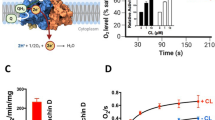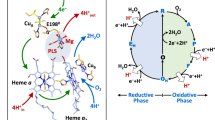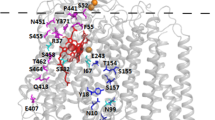Abstract
One of us has previously reported1 that treatment of the Keilin and Hartree heart–muscle preparation2 with 2,3-dimercaptopropanol (BAL), in the presence of air, leads to the complete inactivation of the succinate oxidase system with little if any effect on the activities of succinate dehydrogenase (until more than half the BAL was oxidized) or cytochrome c oxidase. The inactivation of the complete succinate oxidase system requires the oxidation of BAL by air in the presence of the enzyme. It is not caused by H2O2 or BAL disulphides produced during the oxidation of BAL. Spectroscopic studies identified the block as lying between cytochromes b and c. It was suggested that a BAL-labile factor is present which transfers electrons from cytochrome b to cytochrome c and which is destroyed by coupled oxidation with BAL. The factor is also required for NADH oxidation3. Subsequent work showed that it is not identical with cytochrome c1 (ref. 4), myoglobin present in the preparation5 or the antimycin-binding site5. We report here that this factor is identical to the iron–sulphur protein in the central portion of the respiratory chain first identified by Rieske6.
This is a preview of subscription content, access via your institution
Access options
Subscribe to this journal
Receive 51 print issues and online access
$199.00 per year
only $3.90 per issue
Buy this article
- Purchase on Springer Link
- Instant access to full article PDF
Prices may be subject to local taxes which are calculated during checkout
Similar content being viewed by others
References
Slater, E. C. Nature 161, 405–407 (1948).
Keilin, D. & Hartree, E. F. Proc. R. Soc. B129, 277–306 (1940).
Slater, E. C. Nature 165, 674–676 (1950).
Slater, E. C. Nature 163, 532 (1949).
Deul, D. H. & Thorn, M. B. Biochim. biophys. Acta 59, 426–436 (1962).
Rieske, J. S., Hansen, R. E. & Zaugg, W. S. J. biol. Chem. 239, 3017–3022 (1964).
Trumpower, B. L. Biochem. biophys. Res. Commun. 70, 73–80 (1976).
Nishibayashi-Yamashita, H., Cunningham, C. & Racker, E. J. biol. Chem. 247, 698–704 (1972).
Trumpower, B. L. & Edwards, C. A. J. biol. Chem. 254, 8697–8706 (1979).
Heidrich, H.-G., Albracht, S. P. J. & Bäckström, D. FEBS Lett, 95, 314–318 (1978).
Slater, E. C. Biochem. J. 45, 14–30 (1949).
Author information
Authors and Affiliations
Rights and permissions
About this article
Cite this article
Slater, E., de Vries, S. Identification of the BAL-labile factor. Nature 288, 717–718 (1980). https://doi.org/10.1038/288717a0
Received:
Accepted:
Issue Date:
DOI: https://doi.org/10.1038/288717a0
This article is cited by
-
The pathway of electron transfer in the dimeric QH2: Cytochromec oxidoreductase
Journal of Bioenergetics and Biomembranes (1986)
-
Experimental observations on the structure and function of mitochondrial Complex III that are unresolved by the protonmotive ubiquinone-cycle hypothesis
Journal of Bioenergetics and Biomembranes (1986)
-
Thermodynamic and kinetic considerations of Q-cycle mechanisms and the oxidant-induced reduction of cytochromesb
Journal of Bioenergetics and Biomembranes (1985)
Comments
By submitting a comment you agree to abide by our Terms and Community Guidelines. If you find something abusive or that does not comply with our terms or guidelines please flag it as inappropriate.



